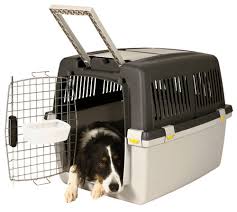
Make Moving with Your Dog Easier
June 20, 2016 | Moving
Does your dog notice when things are different whenever you change your routine? If you are amongst the millions of Americans moving with your dog this year, remember that pets have a sixth sense and tend to know when something is afoot.
If you feel anxious about moving, your dog will pick up on it and may start to get jumpy and bark more. If things feel chaotic and scattered to you, your pet might feel insecure.
Since dogs are territorial animals, moving to another place filled with new sights, sounds, and smells can be a challenge for any dog. Follow our tips on how to plan moving with your dog successfully. Keep your furry friend happy and healthy during your family’s next move.
1. Purchase two sets of identification tags
As soon as you have the address of your new home, and if your dog is not already wearing an ID tag with your current address and phone number, purchase two types of identification tags and attach them both to your dog’s collar.
One tag will have all of your current contact information, and the other tag will have the address of your new home, cell phone number, and new landline number if applicable. Why be so cautious? Moving is not only stressful for your pets, but it is also stressful for you too.
As moving day quickly approaches, the more you will have more on your mind, which means things can start to fall through the cracks. You don’t want to risk forgetting the little details that can make a big difference in the event your pet runs away or gets lost during a move.
2. Make an appointment with the vet before moving with your dog
Most pet owners wait until there is something wrong with their pets before taking them to the veterinary’s office. However, shelling out a few extra bucks to see your veterinarian before you move could save you money in the long run.
Ruling out pet health issues before you move will make it less stressful and easier to relate uncharacteristic pet behavior to the stress of moving, and not an underlying illness.
It may also give you peace of mind to talk to your vet about microchipping your dog before moving. A pet microchip is about the size of a grain of rice and is inserted with a needle. Once your dog is outfitted with the device, you register it using your name and contact information. It is important to remember to keep this information current throughout your pet’s lifetime.
Microchips are not fail-proof, however. There is currently no universal scanner guaranteed to work on every pet microchip brand. Additionally, microchips do not have GPS or other locating capabilities.
If your pet is particularly anxious, you may want to ask your vet for something to help keep your dog calm during the most stressful parts of the move. Certain small dog breeds like Chihuahuas tend to be popular for apartment dwellers, but they also tend to suffer more from anxiety, which can lead to health issues.
This would also be the time to arrange to have your dog’s medical records transferred to your new veterinarian if you are moving far away.
3. Choose the correct sized travel crate
Whether by car, plane, or train, moving with your dog will require a high-quality travel crate. Choosing the right size is essential for the comfort and well-being of your furry friend.
A general rule-of-thumb for measuring your pet for a travel crate is to measure your dog while standing from the base of her tail to the tip of her nose. Add 4-inches to this number and you will know how long your pet’s crate needs to be.
To determine the height of the travel crate, measure the length of your pet while standing from the floor to the top of her head and add 4-inches. This will be how tall the travel crate will need to be to help ensure your pet’s comfort during your move.
Make sure the crate is tall enough for your pet to see out comfortably without ducking while she is standing up and wide enough to allow your dog to turn completely around.
4. Pack your pup’s favorite toys and treats separately
Just like it is advisable to pack an overnight bag with people essentials, you will want to pack favorite toys and treats when moving with your dog.
A helpful hint is to pack pet essentials in a backpack. It may be a few days, or longer before you get to that box with all of your pet’s supplies. Here is what to put in your dog pack:
- Walking harness and leashes
- Waste bags
- Extra treats
- Medications, supplements, and medical records
- Favorite toys
- Food and bowls
Having the essentials in a backpack will not only make everything easily transportable, but it will also leave your hands free for dog wrangling.
5. Reduce pet’s stress when moving with your senior dog
Easing your pet’s transition and reducing pet stress during a move with an older dog takes more time and energy. Whether you are moving across town, or across the country, keep in mind that relocating is stressful for dogs of all ages.
If your move involves a long-distance drive or flight and you have an older dog, have an honest conversation with your vet to discuss your pet’s health and the type of move you are undertaking. A move to another country that involves an international flight might be too traumatic for a senior dog.
Even the most caring owners may forget their dog’s needs during the chaos of moving. The best way to avoid this happening to your pooch is put the planning part of a move with your dog at the top of your list.
Knowing that you have gone the extra mile for your friend and companion that has been loyal to you from day one will make you feel good. Moreover, when you feel happy and calm, your dog knows everything is going to be okay.




